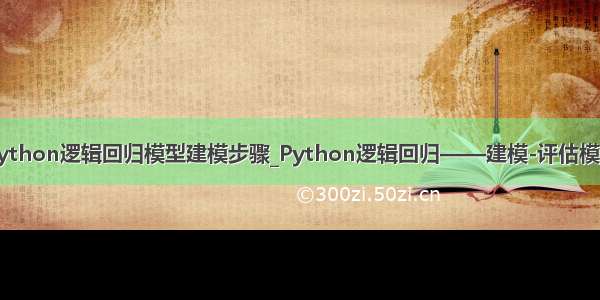
数学建模——逻辑回归模型详解Python代码
程序用到的测试数据:
链接:/s/1LGD1MAxk2lxO93smSPNyZg
提取码:uukr
代码正文
import numpy as npimport pandas as pdimport matplotlib.pyplot as pltimport ospath='data'+os.sep+'Logireg_data.txt'pdData=pd.read_csv(path,header=None,names=['Exam1','Exam2','Admitted'])pdData.head()print(pdData.head())print(pdData.shape)positive=pdData[pdData['Admitted']==1]#定义正nagative=pdData[pdData['Admitted']==0]#定义负fig,ax=plt.subplots(figsize=(10,5))ax.scatter(positive['Exam1'],positive['Exam2'],s=30,c='b',marker='o',label='Admitted')ax.scatter(nagative['Exam1'],nagative['Exam2'],s=30,c='r',marker='x',label='not Admitted')ax.legend()ax.set_xlabel('Exam 1 score')ax.set_ylabel('Exam 2 score')plt.show()#画图##实现算法 the logistics regression 目标建立一个分类器 设置阈值来判断录取结果##sigmoid 函数def sigmoid(z):return 1/(1+np.exp(-z))#画图nums=np.arange(-10,10,step=1)fig,ax=plt.subplots(figsize=(12,4))ax.plot(nums,sigmoid(nums),'r')#画图定义plt.show()#按照理论实现预测函数def model(X,theta):return sigmoid(np.dot(X,theta.T))pdData.insert(0,'ones',1)#插入一列orig_data=pdData.as_matrix()cols=orig_data.shape[1]X=orig_data[:,0:cols-1]y=orig_data[:,cols-1:cols]theta=np.zeros([1,3])print(X[:5])print(X.shape,y.shape,theta.shape)##损失函数def cost(X,y,theta):left=np.multiply(-y,np.log(model(X,theta)))right=np.multiply(1-y,np.log(1-model(X,theta)))return np.sum(left-right)/(len(X))print(cost(X,y,theta))#计算梯度def gradient(X, y, theta):grad = np.zeros(theta.shape)error = (model(X, theta) - y).ravel()for j in range(len(theta.ravel())): # for each parmeterterm = np.multiply(error, X[:, j])grad[0, j] = np.sum(term) / len(X)return grad##比较3种不同梯度下降方法STOP_ITER=0STOP_COST=1STOP_GRAD=2def stopCriterion(type,value,threshold):if type==STOP_ITER: return value>thresholdelif type==STOP_COST: return abs(value[-1]-value[-2])<thresholdelif type==STOP_GRAD: return np.linalg.norm(value)<thresholdimport numpy.random#打乱数据洗牌def shuffledata(data):np.random.shuffle(data)cols=data.shape[1]X=data[:,0:cols-1]y=data[:,cols-1:]return X,yimport timedef descent(data, theta, batchSize, stopType, thresh, alpha):# 梯度下降求解init_time = time.time()i = 0 # 迭代次数k = 0 # batchX, y = shuffledata(data)grad = np.zeros(theta.shape) # 计算的梯度costs = [cost(X, y, theta)] # 损失值while True:grad = gradient(X[k:k + batchSize], y[k:k + batchSize], theta)k += batchSize # 取batch数量个数据if k >= n:k = 0X, y = shuffledata(data) # 重新洗牌theta = theta - alpha * grad # 参数更新costs.append(cost(X, y, theta)) # 计算新的损失i += 1if stopType == STOP_ITER:value = ielif stopType == STOP_COST:value = costselif stopType == STOP_GRAD:value = gradif stopCriterion(stopType, value, thresh): breakreturn theta, i - 1, costs, grad, time.time() - init_time#选择梯度下降def runExpe(data, theta, batchSize, stopType, thresh, alpha):#import pdb; pdb.set_trace();theta, iter, costs, grad, dur = descent(data, theta, batchSize, stopType, thresh, alpha)name = "Original" if (data[:,1]>2).sum() > 1 else "Scaled"name += " data - learning rate: {} - ".format(alpha)if batchSize==n: strDescType = "Gradient"elif batchSize==1: strDescType = "Stochastic"else: strDescType = "Mini-batch ({})".format(batchSize)name += strDescType + " descent - Stop: "if stopType == STOP_ITER: strStop = "{} iterations".format(thresh)elif stopType == STOP_COST: strStop = "costs change < {}".format(thresh)else: strStop = "gradient norm < {}".format(thresh)name += strStopprint ("***{}\nTheta: {} - Iter: {} - Last cost: {:03.2f} - Duration: {:03.2f}s".format(name, theta, iter, costs[-1], dur))fig, ax = plt.subplots(figsize=(12,4))ax.plot(np.arange(len(costs)), costs, 'r')ax.set_xlabel('Iterations')ax.set_ylabel('Cost')ax.set_title(name.upper() + ' - Error vs. Iteration')return thetan= 100runExpe(orig_data,theta,n,STOP_ITER,thresh=5000,alpha=0.000001)plt.show()runExpe(orig_data,theta,n,STOP_GRAD,thresh=0.05,alpha=0.001)plt.show()runExpe(orig_data,theta,n,STOP_COST,thresh=0.000001,alpha=0.001)plt.show()#对比runExpe(orig_data, theta, 1, STOP_ITER, thresh=5000, alpha=0.001)plt.show()runExpe(orig_data, theta, 1, STOP_ITER, thresh=15000, alpha=0.000002)plt.show()runExpe(orig_data, theta, 16, STOP_ITER, thresh=15000, alpha=0.001)plt.show()##对数据进行标准化 将数据按其属性(按列进行)减去其均值,然后除以其方差。#最后得到的结果是,对每个属性/每列来说所有数据都聚集在0附近,方差值为1from sklearn import preprocessing as ppscaled_data = orig_data.copy()scaled_data[:, 1:3] = pp.scale(orig_data[:, 1:3])runExpe(scaled_data, theta, n, STOP_ITER, thresh=5000, alpha=0.001)#设定阈值def predict(X, theta):return [1 if x >= 0.5 else 0 for x in model(X, theta)]# if __name__=='__main__':scaled_X = scaled_data[:, :3]y = scaled_data[:, 3]predictions = predict(scaled_X, theta)correct = [1 if ((a == 1 and b == 1) or (a == 0 and b == 0)) else 0 for (a, b) in zip(predictions, y)]accuracy = (sum(map(int, correct)) % len(correct))print ('accuracy = {0}%'.format(accuracy))
















